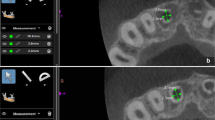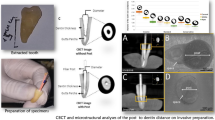Abstract
Objectives
We evaluated a novel micro-computed tomography (micro-CT) assessment for quality and quantity of dentin repair, which is difficult to visualize by histological analysis, after direct pulp capping under standardized cavity preparation.
Materials and methods
Standardized cavities were prepared on Wistar rats and direct pulp capping was performed using two commercial bioceramics, ProRoot MTA, and iRoot BP Plus. After 2 or 4 weeks, quality and quantity of tertiary dentin formation were evaluated using high-resolution micro-CT analyses including dentin mineral density, dentin mineral contents, compactness and integrity of tertiary dentin, and dentin volume with/without void space. Reproducibility of micro-CT analyses was confirmed by histological evaluation of the same specimen.
Results
The exposed pulp area sizes were similar between iRoot BP Plus and ProRoot MTA. Micro-CT analysis of 2-week samples showing compactness of tertiary dentin was significantly higher in iRoot BP Plus than ProRoot MTA (p < 0.05). Tertiary dentin volume without void space, dentin mineral contents, and density were not significantly different between the groups. In 4-week samples, a significant increase was observed in dentin mineral density, compactness, and dentin volume with/without void space induced by iRoot BP Plus (p < 0.05). Micro-CT analysis of tertiary dentin integrity demonstrated that some ProRoot MTA specimens had small defects and lacked continuity (6/512 images). No defects were observed with iRoot BP Plus.
Conclusions
Micro-CT analysis was confirmed as an accurate, objective, and inclusive approach for evaluating quality and quantity of dentin repair.
Clinical relevance
These multifaceted approaches to evaluate pulp capping materials may accelerate review processes, ultimately improving vital pulp therapy.



Similar content being viewed by others
References
Takita T, Hayashi M, Takeichi O, Ogiso B, Suzuki N, Otsuka K, Ito K (2006) Effect of mineral trioxide aggregate on proliferation of cultured human dental pulp cells. Int Endod J 39(5):415–422. https://doi.org/10.1111/j.1365-2591.2006.01097.x
Iohara K, Nakashima M, Ito M, Ishikawa M, Nakasima A, Akamine A (2004) Dentin regeneration by dental pulp stem cell therapy with recombinant human bone morphogenetic protein 2. J Dent Res 83(8):590–595. https://doi.org/10.1177/154405910408300802
Ominsky MS, Boyd SK, Varela A, Jolette J, Felx M, Doyle N, Mellal N, Smith SY, Locher K, Buntich S, Pyrah I, Boyce RW (2017) Romosozumab improves bone mass and strength while maintaining bone quality in ovariectomized cynomolgus monkeys. J Bone Miner Res 32(4):788–801. https://doi.org/10.1002/jbmr.3036
Chen X, Wang C, Zhang K, Xie Y, Ji X, Huang H, Yu X (2016) Reduced femoral bone mass in both diet-induced and genetic hyperlipidemia mice. Bone 93:104–112. https://doi.org/10.1016/j.bone.2016.09.016
Ishimoto K, Hayano S, Yanagita T, Kurosaka H, Kawanabe N, Itoh S, Ono M, Kuboki T, Kamioka H, Yamashiro T (2015) Topical application of lithium chloride on the pulp induces dentin regeneration. PLoS One 10(3):e0121938. https://doi.org/10.1371/journal.pone.0121938
Al-Hezaimi K, Salameh Z, Al-Fouzan K et al (2011) Histomorphometric and micro-computed tomography analysis of pulpal response to three different pulp capping materials. J Endod 37(4):507–512. https://doi.org/10.1016/j.joen.2010.11.001
Lee W, Oh JH, Park JC, Shin HI, Baek JH, Ryoo HM, Woo KM (2012) Performance of electrospun poly(ε-caprolactone) fiber meshes used with mineral trioxide aggregates in a pulp capping procedure. Acta Biomater 8(8):2986–2995. https://doi.org/10.1016/j.actbio.2012.04.032
Queiroz AM, Assed S, Leonardo MR et al (2005) MTA and calcium hydroxide for pulp capping. J Appl Oral Sci 13(2):126–130. https://doi.org/10.1590/S1678-77572005000200006
Iwamoto CE, Adachi E, Pameijer CH, Barnes D, Romberg EE, Jefferies S (2006) Clinical and histological evaluation of white ProRoot MTA in direct pulp capping. Am J Dent 19(2):85–90
De Souza Costa CA, Duarte PT, de Souza PP et al (2008) Cytotoxic effects and pulpal response caused by a mineral trioxide aggregate formulation and calcium hydroxide. Am J Dent 21(4):255–261
Min KS, Park HJ, Lee SK, Park SH, Hong CU, Kim HW, Lee HH, Kim EC (2008) Effect of mineral trioxide aggregate on dentin bridge formation and expression of dentin sialoprotein and heme-oxygenase-1 in human dental pulp. J Endod 34(6):666–670. https://doi.org/10.1016/j.joen.2008.03.009
Paranjpe A, Smoot T, Zhang H, Johnson JD (2011) Direct contact with mineral trioxide aggregate activates and differentiates human dental pulp cells. J Endod 37(12):1691–1695. https://doi.org/10.1016/j.joen.2011.09.012
Parirokh M, Torabinejad M (2010) Mineral trioxide aggregate: a comprehensive literature review—part III: clinical applications, drawbacks, and mechanism of action. J Endod 36(3):400–413. https://doi.org/10.1016/j.joen.2009.09.009
Mitsiadis TA, Woloszyk A, Jiménez-Rojo L (2012) Nanodentistry: combining nanostructured materials and stem cells for dental tissue regeneration. Nanomedicine 7(11):1743–1753. https://doi.org/10.2217/nnm.12.146
De-Deus G, Canabarro A, Alves GG et al (2012) Cytocompatibility of the ready-to-use bioceramic putty repair cement iRoot BP plus with primary human osteoblasts. Int Endod J 45(6):508–513. https://doi.org/10.1111/j.1365-2591.2011.02003.x
Zhou W, Zheng Q, Tan X, Song D, Zhang L, Huang D (2017) Comparison of mineral trioxide aggregate and iRoot BP plus root repair material as root-end filling materials in endodontic microsurgery: a prospective randomized controlled study. J Endod 43(1):1–6. https://doi.org/10.1016/j.joen.2016.10.010
Leal F, De-Deus G, Brandão C et al (2013) Similar sealability between bioceramic putty ready-to-use repair cement and white MTA. Braz Dent J 24(4):362–366. https://doi.org/10.1590/0103-6440201302051
Damlar I, Ozcan E, Yula E et al (2014) Antimicrobial effects of several calcium silicate-based root-end filling materials. Dent Mater J 33(4):453–457. https://doi.org/10.4012/dmj.2013-250
Zhang J, Zhu LX, Cheng X, Lin Y, Yan P, Peng B (2015) Promotion of dental pulp cell migration and pulp repair by a bioceramic putty involving FGFR-mediated signaling pathways. J Dent Res 94(6):853–862. https://doi.org/10.1177/0022034515572020
Stanley HR (1989) Pulp capping: conserving the dental pulp—can it be done? Is it worth it? Oral Surg Oral Med Oral Pathol 68(5):628–639. https://doi.org/10.1016/0030-4220(89)90252-1
Lin HP, Tu HP, Hsieh YP, Lee BS (2017) Controlled release of lovastatin from poly(lactic-co-glycolic acid) nanoparticles for direct pulp capping in rat teeth. Int J Nanomedicine 12:5473–5485. https://doi.org/10.2147/IJN.S138410
Suzuki M, Taira Y, Kato C, Shinkai K, Katoh Y (2016) Histological evaluation of direct pulp capping of rat pulp with experimentally developed low-viscosity adhesives containing reparative dentin-promoting agents. J Dent 44:27–36. https://doi.org/10.1016/j.jdent.2015.11.005
Costa CA, Oliveira MF, Giro EM et al (2003) Biocompatibility of resin-based materials used as pulp-capping agents. Int Endod J 36(12):831–839. https://doi.org/10.1111/j.1365-2591.2003.00702.x
Chang SW, Lee SY, Ann HJ, Kum KY, Kim EC (2014) Effects of calcium silicate endodontic cements on biocompatibility and mineralization-inducing potentials in human dental pulp cells. J Endod 40(8):1194–1200. https://doi.org/10.1016/j.joen.2014.01.001
Andelin WE, Shabahang S, Wright K et al (2003) Identification of hard tissue after experimental pulp capping using dentin sialoprotein (DSP) as a marker. J Endod 29(10):646–650. https://doi.org/10.1097/00004770-200310000-00008
Zhang S, Yang X, Fan M (2013) BioAggregate and iRoot BP plus optimize the proliferation and mineralization ability of human dental pulp cells. Int Endod 46(10):923–929. https://doi.org/10.1111/iej.12082
Chang SW, Lee SY, Kum KY, Kim EC (2014) Effects of ProRoot MTA, Bioaggregate, and micromega MTA on odontoblastic differentiation in human dental pulp cells. J Endod 40(1):113–118. https://doi.org/10.1016/j.joen.2013.09.036
Tian J, Zhang Y, Lai Z, Li M, Huang Y, Jiang H, Wei X (2017) Ion release, microstructural, and biological properties of iRoot BP plus and ProRoot MTA exposed to an acidic environment. J Endod 43(1):163–168. https://doi.org/10.1016/j.joen.2016.10.011
Yildirim S, Can A, Arican M et al (2011) Characterization of dental pulp defect and repair in a canine model. Am J Dent 24:331–335
Zhu L, Yang J, Zhang J, Lei D, Xiao L, Cheng X, Lin Y, Peng B (2014) In vitro and in vivo evaluation of a nanoparticulate bioceramic paste for dental pulp repair. Acta Biomater 10(12):5156–5168. https://doi.org/10.1016/j.actbio.2014.08.014
Torabinejad M, Parirokh M (2010) Mineral trioxide aggregate: a comprehensive literature review—part II: leakage and biocompatibility investigations. J Endod 36(2):190–202. https://doi.org/10.1016/j.joen.2009.09.010
Funding
This work was supported by JSPS KAKENHI (grant numbers JP16K20453, 17H06848, and 17K11704).
Author information
Authors and Affiliations
Corresponding author
Ethics declarations
Conflict of interest
The authors declare that they have no conflicts of interest.
Ethical approval
The animal experimental protocol in this study was approved by the Ethical Guidelines Committee for Animal Care of Osaka University Graduate School of Dentistry (no. 23-005-1). All surgeries were performed under general anesthesia and efforts were made to minimize suffering.
Informed consent
For this type of study, formal consent is not required.
Electronic supplementary material
ESM 1
(DOCX 1.15 mb).
Rights and permissions
About this article
Cite this article
Okamoto, M., Takahashi, Y., Komichi, S. et al. Novel evaluation method of dentin repair by direct pulp capping using high-resolution micro-computed tomography. Clin Oral Invest 22, 2879–2887 (2018). https://doi.org/10.1007/s00784-018-2374-5
Received:
Accepted:
Published:
Issue Date:
DOI: https://doi.org/10.1007/s00784-018-2374-5




